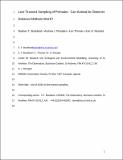Files in this item
Line transect sampling of primates : can animal-to-observer distance methods work?
Item metadata
| dc.contributor.author | Buckland, Stephen Terrence | |
| dc.contributor.author | Plumptre, A J | |
| dc.contributor.author | Thomas, Len | |
| dc.contributor.author | Rexstad, Eric | |
| dc.date.accessioned | 2011-07-22T10:30:11Z | |
| dc.date.available | 2011-07-22T10:30:11Z | |
| dc.date.issued | 2010-06 | |
| dc.identifier | 458818 | |
| dc.identifier | c20f12db-1a8b-45b3-af33-904da6750617 | |
| dc.identifier | 77952420417 | |
| dc.identifier | 000277641900009 | |
| dc.identifier.citation | Buckland , S T , Plumptre , A J , Thomas , L & Rexstad , E 2010 , ' Line transect sampling of primates : can animal-to-observer distance methods work? ' , International Journal of Primatology , vol. 31 , no. 3 , pp. 485-499 . https://doi.org/10.1007/s10764-010-9408-4 | en |
| dc.identifier.issn | 0164-0291 | |
| dc.identifier.other | standrews_research_output: 31419 | |
| dc.identifier.other | ORCID: /0000-0002-7436-067X/work/29591715 | |
| dc.identifier.other | ORCID: /0000-0002-4323-8161/work/29574872 | |
| dc.identifier.other | ORCID: /0000-0002-9939-709X/work/73700976 | |
| dc.identifier.uri | https://hdl.handle.net/10023/1926 | |
| dc.description | An erratum to this article can be found at http://dx.doi.org/10.1007/s10764-010-9469-4 | en |
| dc.description.abstract | Line transect sampling is widely used for estimating abundance of primate populations. Animal-to-observer distances (AODs) are commonly used in analysis, in preference to perpendicular distances from the line. This is in marked contrast with standard practice for other applications of line transect sampling. We formalize the mathematical shortcomings of approaches based on AODs, and show that they are likely to give strongly biased estimates of density. We review papers that claim good performance for the method, and explore this performance through simulations. These confirm strong bias in estimates of density using AODs. We conclude that AOD methods are conceptually flawed, and that they cannot in general provide valid estimates of density. | |
| dc.format.extent | 15 | |
| dc.format.extent | 102082 | |
| dc.language.iso | eng | |
| dc.relation.ispartof | International Journal of Primatology | en |
| dc.subject | animal-to-observer distances | en |
| dc.subject | Distance sampling | en |
| dc.subject | Estimating primate density | en |
| dc.subject | Kelker strip | en |
| dc.subject | Modified Kelker method | en |
| dc.subject | Primate survey | en |
| dc.subject | QA Mathematics | en |
| dc.subject.lcc | QA | en |
| dc.title | Line transect sampling of primates : can animal-to-observer distance methods work? | en |
| dc.type | Journal article | en |
| dc.contributor.institution | University of St Andrews. Marine Alliance for Science & Technology Scotland | en |
| dc.contributor.institution | University of St Andrews. School of Mathematics and Statistics | en |
| dc.contributor.institution | University of St Andrews. Scottish Oceans Institute | en |
| dc.contributor.institution | University of St Andrews. Centre for Research into Ecological & Environmental Modelling | en |
| dc.identifier.doi | 10.1007/s10764-010-9408-4 | |
| dc.description.status | Peer reviewed | en |
| dc.identifier.url | http://www.scopus.com/inward/record.url?scp=77952420417&partnerID=8YFLogxK | en |
| dc.identifier.url | http://www.creem.st-and.ac.uk/len/papers/BucklandIJP2009a.pdf | en |
This item appears in the following Collection(s)
Items in the St Andrews Research Repository are protected by copyright, with all rights reserved, unless otherwise indicated.

